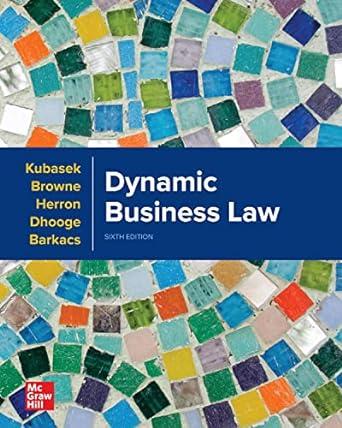SWIGART v. BRUNO CALIFORNIA COURT OF APPEALS 13 CAL. APP. 5TH 529 2017 According to the American
Question:
SWIGART v. BRUNO CALIFORNIA COURT OF APPEALS 13 CAL. APP. 5TH 529 2017 According to the American Endurance Ride Conference, endurance riding is a “highly competitive and demanding sport.” It is described in the AERC handbook as a sports activity as well as an “equestrian athletic event.” Kathleen Swigart and Carl Bruno were two participants in an endurance riding event, joining 47 others to ride a 50-mile course.
Less than two hours into the race, Swigart, Bruno, and five others were slowing down in a single file line to stop at a checkpoint to pick up race cards. At the checkpoint, Swigart dismounted to collect cards for everyone in the group. In the process of gathering the cards, Bruno’s horse bumped into the horse ahead of him. The bumped horse retaliated by kicking Bruno’s horse. Bruno was thrown from his horse, and the horse fled, crashing into Swigart, who was standing on the ground.
Swigart subsequently filed a suit against Bruno, alleging among other claims, negligence. Bruno filed a motion for summary judgment under the theory that the assumption of the risk doctrine precluded Swigart’s negligence cause of action. The court granted Bruno’s motion and Swigart appealed.
JUDGE AARON “Everyone is responsible … for an injury occasioned to another by his or her want of ordinary care or skill in the management of his or her property or person….” Stated differently, “each person has a duty to use ordinary care and ‘is liable for injuries caused by his [or her] failure to exercise reasonable care in the circumstances.’” … Primary assumption of risk is a defense that relieves a defendant of any duty to the plaintiff when the plaintiff is injured due to a risk that is inherent in an activity in which the plaintiff chose to participate.
…[T]he general test is “that a participant in an active sport breaches a legal duty of care to other participants—i.e., engages in conduct that properly may subject him or her to financial liability—only if the participant intentionally injures another player or engages in conduct that is so reckless as to be totally outside the range of the ordinary activity involved in the sport.” Although a defendant has no duty of care to a plaintiff with regard to inherent risks, a defendant still has a duty not to increase those risks.
In analyzing whether Bruno owed Swigart a duty at the Ride, we consider whether the risk of being struck by a coparticipant’s horse that follows other horses so closely as to come into contact with them is “’inherent in’” the activity of endurance riding. In determining whether a risk is inherent in an activity, we consider “the record and common sense.”
Our review of the record on appeal—which includes the documentary evidence and the more than 40 minutes of video of the Ride—enables us to determine what is inherent in the activity of endurance riding. Applying case law concerning horses, as well as common sense, to the undisputed facts surrounding the Ride and Swigart’s injury, we conclude that, as a matter of law, primary assumption of the risk bars Swigart’s claim for negligence.
Swigart’s claim for negligence—which Swigart supports with evidence that Bruno was unable to control his horse, refused to heed safety warnings from coparticipants and continued to participate in the event after becoming aware of these safety risks—is premised primarily on evidence that Bruno’s horse tailgated and rear-ended other horses. Based on our review of Stevens’s video, given the amount of tailgating by many of the riders in the first group in the Ride —particularly as the group approached the second card stop at the eight-mile checkpoint immediately before Swigart’s injury—testimony that such behavior is not part of the sport of endurance riding simply is not credible. For example, on too many occasions to count, Stevens allowed her horse to tailgate, and even come up next to the rear of the horse in front of hers—despite the fact that the horse in front of hers wore a red ribbon in its tail, which, Stevens testified, is used by a rider “to designate a horse likely to kick on a trail ride.”
Swigart was injured by Bruno’s horse, which bolted out of control as a group of seven horses in a single-file line came to a stop in a narrow area. In the process of slowing down, Bruno’s horse bumped the rear of Stevens’s horse, Stevens’s horse kicked Bruno’s horse, Bruno was thrown from his horse, and Bruno’s horse took off, sideswiping two horses ahead and striking Swigart, who was standing on the ground at a Ride checkpoint. Because this type of equine conduct is among the risks inherent in endurance riding, the assumption of the risk doctrine applies to Swigart’s claims based on Bruno’s alleged negligence.
Accordingly, as a matter of law, Bruno did not owe Swigart a duty of due care to protect her from the risk of the harm that she suffered during the Ride.
AFFIRMED.
CRITICAL THINKING:
To what extent can a judge discern what an “inherent risk” is in a subject matter if she is not an expert on the topic? Do you agree with the appellate judge’s decision on what an inherent risk in this case was?
ETHICAL DECISION MAKING:
What values are embodied in the assumption-of-the-risk defense? Which stakeholders do you think it is meant to benefit?
Step by Step Answer:

Dynamic Business Law
ISBN: 9781260733976
6th Edition
Authors: Nancy Kubasek, M. Neil Browne, Daniel Herron, Lucien Dhooge, Linda Barkacs





